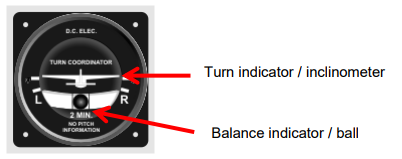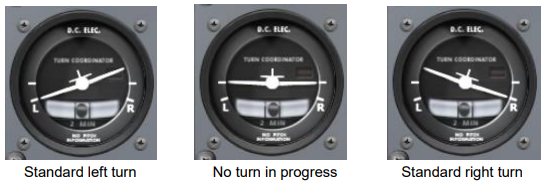¶ Aspect
The turn coordinator (turn and balance indicator) are essentially two aircraft flight instruments in one device. They each act as a rate of turn indicator that displays the rate the aircraft heading is changing and a balance indicator or slip indicator that displays the slip or skid of the turn.

The turn indicator display contains hash marks where the needle may align during a turn. When the needle is lined up with these hash marks, the aircraft is performing a standard rate turn.
The standard rate (or named rate "one") for most airplanes is three degrees per second or two minutes per 360 degrees of turn (a complete circle). This is marked as "2 min" on the display.
The balance indicator information of the aircraft is often obtained by an inclinometer, which is recognized as the ball in a tube
¶ Use

Note that in a standard turn, the ball in the balance indicator is always centered.

If it is not centered, the turn will be asymmetrical and the aircraft will be skidding/slipping.
The turn coordinator should be used as a performance instrument when the attitude indicator has failed.
- None
- VID 150259 - Creation
- VID 200696 - Update
- VID 496402 - Wiki.js integration